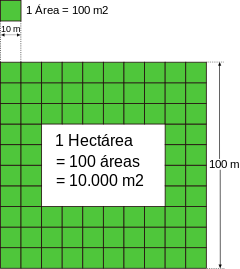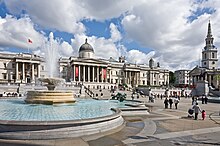Hectare
The hectare or square hectometre (from the French prefix hecto-, and this from the alteration of the Greek ἑκατόν [hekatón] , meaning 'one hundred') is a measure of area equal to 100 areas or 10,000 m² (square meters). It is the surface that occupies a square of 100 meters of side.
The symbol for hectare is ha, and for square hectometre is hm². These, being unit symbols, should never have a point (unless the punctuation corresponds to the end of a sentence). Contrary to what it may seem from the number of times they appear written with an initial capital letter, these symbols should not be written this way either, as is the case with all symbols with the prefix hecto-.
Description
The hectare, while not an SI unit, is the only named unit of area that is accepted for use with SI units. The name was coined in French, from the Latin ārea In practice, the hectare is derived entirely from the SI, which is equivalent to one square hectometre. It is widely used around the world to measure large areas of land, and is the legal unit of measurement in domains related to land ownership, planning, and management, including law (land titles), agriculture, forestry and urban planning throughout the European Union and Australia (since 1970). However, the United Kingdom, the United States, Burma, and, to some extent, Canada use the acre instead.
Some countries that experienced a general conversion from traditional measurements to metric measurements (for example, Canada) required a new survey when units of measurement in land-related legal descriptions were converted to metric units. Others, such as South Africa, published conversion factors that should be used especially "when preparing compilation charts".
In many countries, metrication redefined or clarified existing measurements in terms of metric units. The following legacy area units have been redefined as equivalent to one hectare:
- Jerib in Iran
- Djerib in Turkey
- Gong Qing (Traditional Chinese-Chinese-Chinese-Simplified Gōngq visng in Pinyin) in Great China
- Apple in Argentina
- Bunder in the Netherlands (up to 1937)
History
The metric system of measurement was first given a legal basis in 1795 by the French revolutionary government. The law of 18 Germinal, Year III (April 7, 1795) defined five units of measurement:
- The meter in length.
- The area (100 m2) per [land] area.
- The stereo (1 m3) by stacked wood volume.
- The litre (1 dm3) for liquid volumes.
- Gram for mass
In 1960, when the metric system was updated as the International System of Units (SI), the system did not receive international recognition. The International Committee for Weights and Measures (CIPM) does not mention area in the current (2006) SI definition, but classifies the hectare as a "non-SI unit accepted for use with the International System of Units".
In 1972, the European Economic Community (EEC) approved directive 71/354/EEC, which cataloged the units of measurement that could be used within the Community. The units that were cataloged replicated the CGPM recommendations, complemented by some other units including the are (and implicitly the hectare) whose use was limited to land measurement.
Family of units
The denominations centiare, deciare, decaree and hectare are obtained by adding the standard metric prefixes to the unit basic original surface area, the area.
Decimilarea
The decimiliarea (sometimes seen in the evaluation of the cadastre area of real estate parcels) is 1⁄10,000 area or one square decimeter.
Centiarea
A centiare is a square meter.
Deciarea
The deciarea is ten square meters. It is rarely used.
Area
The area is a unit of surface, equal to 100 square meters (10 m × 10 m), used to measure the terrestrial surface. It was defined by older forms of the metric system, but is now outside the modern International System of Units (SI). It is still commonly used in publications to measure real estate, particularly in Indonesia, India, and several countries in Europe.
In Russian and some other languages of the former Soviet Union, the area is called sotka (in Russian, сотка: 'one hundred', i.e. 100 m² or 1⁄100 hectare). It is used to describe the size of suburban dacha plots or orchards or small city parks where the hectare would be too large.
Decares
The decaree is derived from deca and area, and is equal to 10 areas or 1000 square meters. It is used in Norway and in the former Ottoman areas of the Middle East and the Balkans (Bulgaria) as a measure of land area. Instead of the denomination "decarea", the names of the traditional measures of land are usually used, redefined as a decaree:
- Stremma in Greece.
- Dunam, dunum, donum or dönüm in Israel, Palestine, Jordan, Lebanon, Syria and Turkey.
- Mål is used for decay in Norway, from the old measure of approximately the same surface.
Equivalences in the International System of Units (SI)
One hectare is equal to:
- 10 000 000 000 mm2
- 100 000 000 cm2
- 1 000 000 dm2
- 10 000 m2
- 100 dam2 or areas
- 1 hm2
- 0.01 km2
A square kilometer equals 100 ha.
Equivalences in other units
Anglo-Saxon system
- 0.003 861 020 square miles
- 2,471 053 814 6717 international acres
- 2,471 043 9 American acres
- 107 640 square feet
Others
- 0.590 rural blocks (in Argentina)
- 10 metric dunams
- 13,982 493 917 615 1 fanegas (Ancient crown of Aragon)
- 1,43 apples
Contenido relacionado
Benito Juarez (Mexico City)
Fee
Holy Cross of the Sierra

